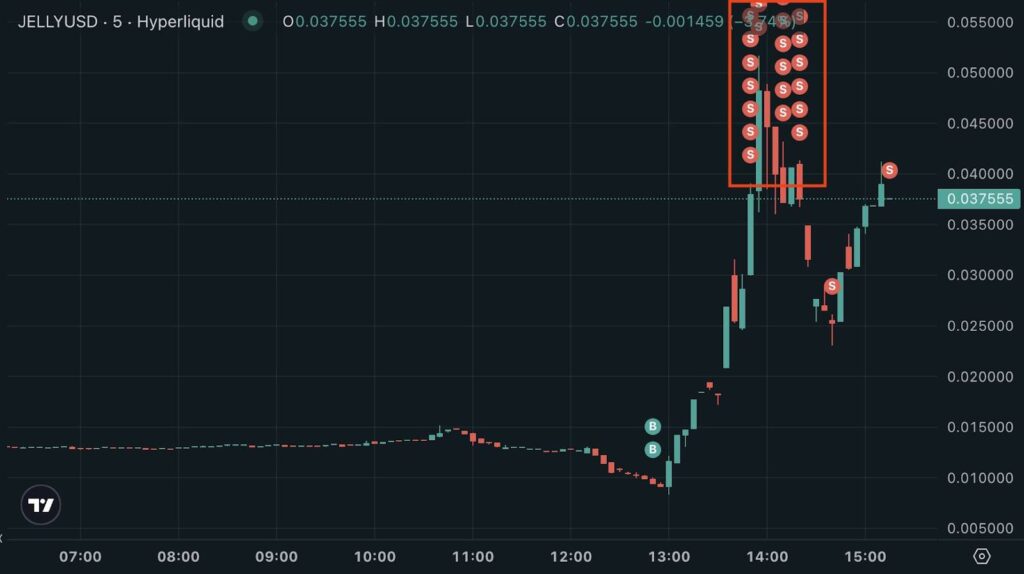In the ever-evolving world of cryptocurrency, decentralized exchanges (DEXs) are making headlines as they increasingly challenge the established dominance of centralized platforms. A recent incident involving Hyperliquid, a decentralized exchange, has underscored the risks associated with DEX infrastructure, as highlighted by a staggering $6.2 million exploit carried out by a cryptocurrency whale. On March 27, 2023, reports emerged that the whale profited significantly by manipulating the liquidation parameters of a memecoin named Jelly my Jelly (JELLY), igniting discussions about both the vulnerabilities and potential of DEXs in the growing cryptocurrency landscape.
This incident represented the second major exploit on Hyperliquid within a short timeframe, raising eyebrows across the industry. CoinGecko co-founder Bobby Ong pointed out in an April 3 social media post that the attack on $JELLYJELLY coincided with heightened activity from centralized exchanges like Binance and OKX, suggesting accusations of a coordinated effort to undermine Hyperliquid. As the competition heats up, it is clear that centralized exchanges are feeling the pressure from the burgeoning DEX market.
Hyperliquid has garnered attention as it ranks as the eighth-largest perpetual futures exchange by trading volume when comparing both decentralized and centralized platforms. Remarkably, it has outperformed established players like Kraken and BitMEX. However, despite its impressive trading volume, Hyperliquid’s market share remains far behind that of Binance, which boasts a colossal $19.5 billion in open interest.
Interestingly, the fallout from the exploit has raised concerns over user confidence in decentralized platforms. Analysts like Ryan Lee from Bitget Research warn that Hyperliquid’s response to the attack, which included freezing and delisting the affected memecoin, may appear overly centralized and could deter potential users from engaging with similar platforms in the future. The balance between innovative decentralization and necessary centralization for security remains a delicate issue.
The mechanics of the exploit itself involved the whale executing large trading positions, including two long positions valued at $2.15 million and $1.9 million, paired with a $4.1 million short position. When the price of JELLY surged by 400%, the massive short position was not liquidated immediately due to its size, instead becoming integrated within Hyperliquid’s liquidity provider vault, designed to handle large trades. This complicated trading logic illustrates the unique risks inherent in the DEX model.
As the cryptocurrency landscape continues to evolve, these developments signal a critical moment for decentralized exchanges. With incidents like the one on Hyperliquid, the industry must navigate the complexities of maintaining user trust while fostering innovation, ensuring that the growth of DEXs doesn’t come at the expense of security and user confidence.
Decentralized Cryptocurrency Exchanges: Risks and Impact
Decentralized cryptocurrency exchanges (DEXs) are becoming a significant force in the market, but recent events, particularly the $6.2 million exploit on Hyperliquid, underscore the inherent risks involved. Here are the key points regarding this situation:
- Recent Exploit at Hyperliquid:
- A cryptocurrency whale made over $6.2 million by exploiting liquidation parameters on the DEX Hyperliquid.
- This was the second major incident for Hyperliquid in March, highlighting vulnerabilities within DEX infrastructure.
- Market Response from Centralized Exchanges (CEXes):
- The exploit has led to accusations of retaliatory actions by centralized exchanges, which feel threatened by the rise of DEXs.
- Centralized exchanges like Binance and OKX are responding to protect their market share against emerging DEX platforms.
- Hyperliquid’s Market Position:
- Hyperliquid ranks as the eighth-largest perpetual futures exchange, surpassing notable traditional platforms.
- Despite its growth, it still lags behind Binance in terms of trading volume and open interest.
- Impact on User Confidence:
- The exploit and subsequent intervention by Hyperliquid may undermine user confidence in decentralized platforms.
- If actions taken appear overly centralized, potential investors may become wary, affecting future participation.
- Nature of the Exploit:
- The whale used sophisticated trading strategies, including large long and short positions, to exploit Hyperliquid’s trading logic.
- Despite Hyperliquid’s efforts to freeze and delist the affected memecoin, the whale still held a significant amount of the token, indicating the potential for further impacts on market dynamics.
These key points highlight the ongoing evolution and risks associated with decentralized cryptocurrency exchanges. As DEXs continue to grow, their challenges will directly impact traders, investors, and the broader cryptocurrency ecosystem.
Decentralized Exchanges Under Scrutiny: The Impact of Hyperliquid’s Recent Exploit
The rise of decentralized exchanges (DEXs) has fundamentally altered the cryptocurrency landscape, presenting a formidable challenge to traditional centralized exchanges (CEXs). Recent incidents, particularly the $6.2 million exploit on Hyperliquid, underscore the vulnerabilities inherent in DEX infrastructures, highlighting both the opportunities and risks tied to this innovative trading model.
Competitive Advantages of DEXs: One of the significant advantages DEXs offer is enhanced privacy and reduced regulatory scrutiny, appealing to users who prioritize security and autonomy over their assets. Hyperliquid has carved a niche for itself in the derivatives market, emerging as the eighth-largest perpetual futures exchange, surpassing some established platforms like Kraken and BitMEX. This rapid ascent illustrates the growing traction DEXs are gaining, as more traders move towards platforms that promise greater transparency and lower fees.
Challenges Faced: However, the recent exploit raises critical questions about the security frameworks that DEXs employ. The incident highlights how a single trader, or ‘whale,’ can manipulate market conditions to their advantage, potentially eroding user trust. Analysts warn that if platforms like Hyperliquid engage in interventions perceived as overly centralized, it could alienate their user base, sowing doubt among investors about the true decentralized nature of these exchanges.
Furthermore, as DEXs continue to gain market share, competition with established CEXs is intensifying. The conflict may lead centralized platforms to explore strategies that could undermine the perceived safety and reliability of decentralized systems. With CEXs feeling threatened, they may resort to tactics designed to retain their position, potentially creating a fierce battle in the crypto space.
Who Will Benefit, Who Will Face Challenges: For retail investors and crypto enthusiasts seeking freedom from centralized control, DEXs like Hyperliquid offer a promising alternative. However, the risks highlighted by the recent exploit could deter new users from engaging with these platforms, demanding that they weigh the benefits of decentralization against the potential for financial loss resulting from security lapses. Trade professionals and institutional investors may find themselves re-evaluating their strategies in light of evolving market dynamics, possibly leading to a more cautious approach towards leveraging DEXs in their portfolios.
In great contrast, for hackers and market manipulators, the evolving vulnerabilities in DEX infrastructure present lucrative opportunities for exploitation. As these platforms move towards decentralization and anonymity, the risk of repeating similar incidents remains high, rendering specific segments of the cryptocurrency market precarious and unpredictable.

















